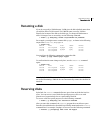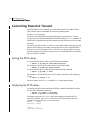
122 Administering disks
Controlling Powerfail Timeout
Controlling Powerfail Timeout
Powerfail Timeout is an attribute of a SCSI disk connected to an HP-UX host.
This is used to detect and handle I/O on non-responding disks.
See the pfto(7) man page.
VxVM uses this mechanism in its Powerfail Timeout (pfto) feature. You can
specify a timeout value for individual VxVM disks using the vxdisk command. If
a disk fails to respond in the specified timeout period, the driver receives a timer
interrupt.
You can set the PFTO values on a disk or a set of disks within a disk group using
the CLI. PFTO helps in preventing system hangs due to non-responding disks.
However, in some circumstances, it is critical to retry the I/O until it succeeds,
regardless of how long it takes. In those cases, you can disable PFTO. By default,
the use of PFTO is enabled.
Setting the PFTO values
To set the PFTO value on a disk, use the following command:
$ vxdisk -g dg_name set disk_name pfto=value
For example, to set the PFTO value of 50sec on the disk c5t0d6:
$ vxdisk -g testdg set c5t0d6 pfto=50
To set the PFTO value on a disk group, use the following command:
$ vxpfto -g dg_name -t value
For example, to set the PFTO value to 50 seconds on all disks in the diskgroup
testdg:
$ vxpfto -g testdg -t 50
For more details, see the vxpfto(1M) and vxdisk(1M) manual pages.
Displaying the PFTO values
To display the PFTO value and whether PFTO is enabled or disabled for a disk,
use one of the following commands:
$ vxprint -g dg_name -l disk_name
$ vxdisk -g dg_name list disk_name
The output shows the pftostate field, which indicates whether PFTO is
enabled or disabled. The timeout field shows the PFTO timeout value. For
example, the output for the c5t0d6 disk shows:
Device: c5t0d6
devicetag: c5t0d6
...
timeout: 30
pftostate: disabled
...


















